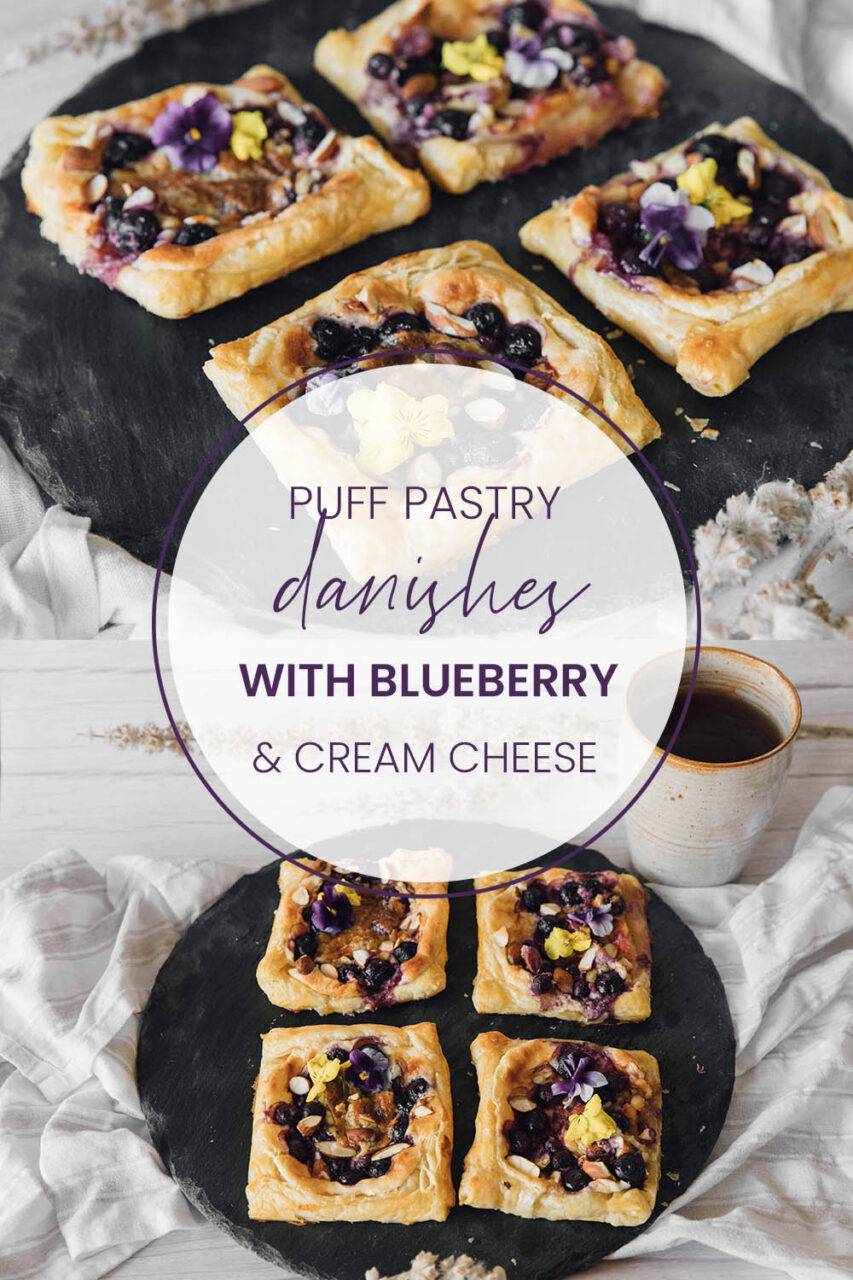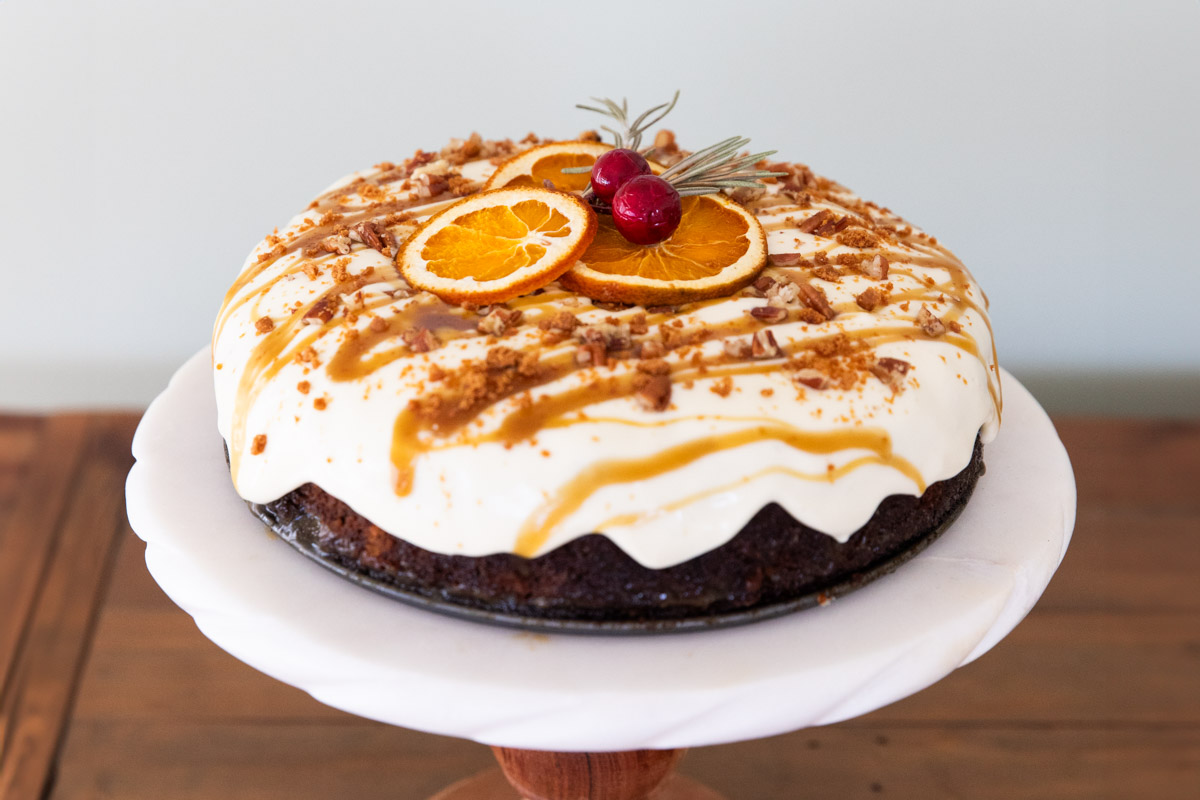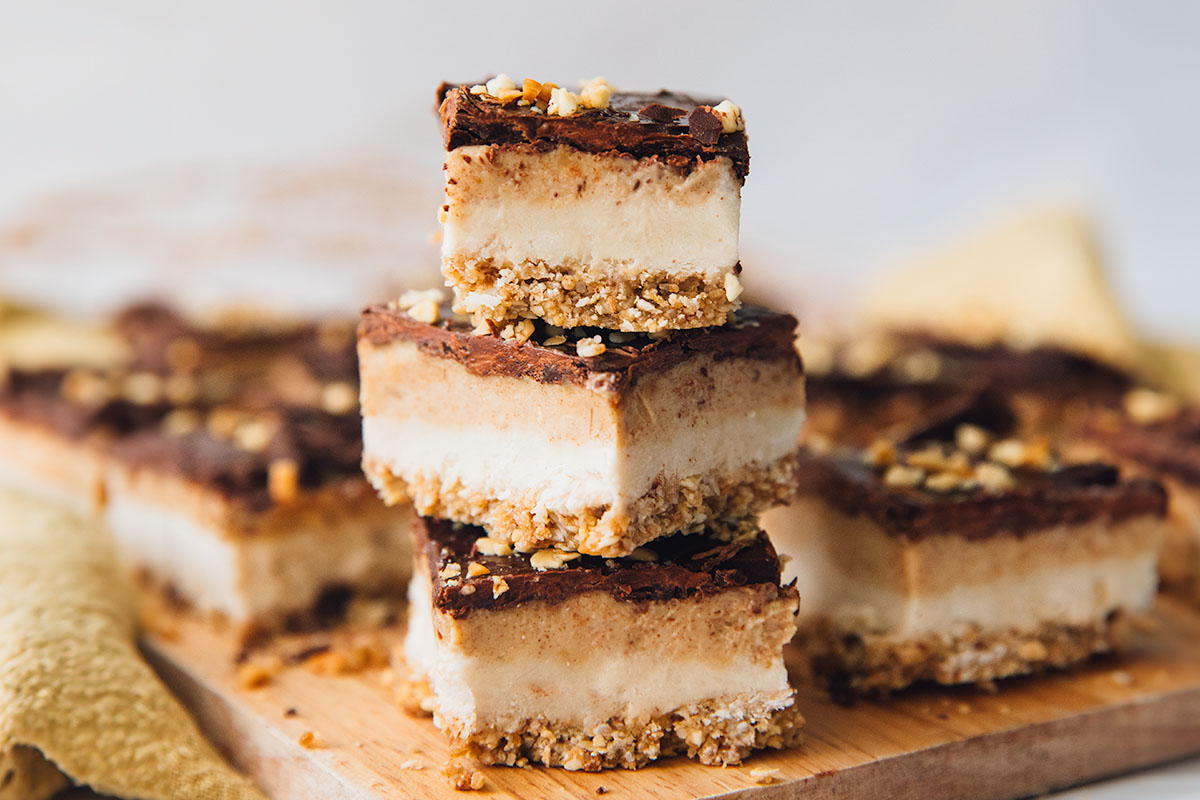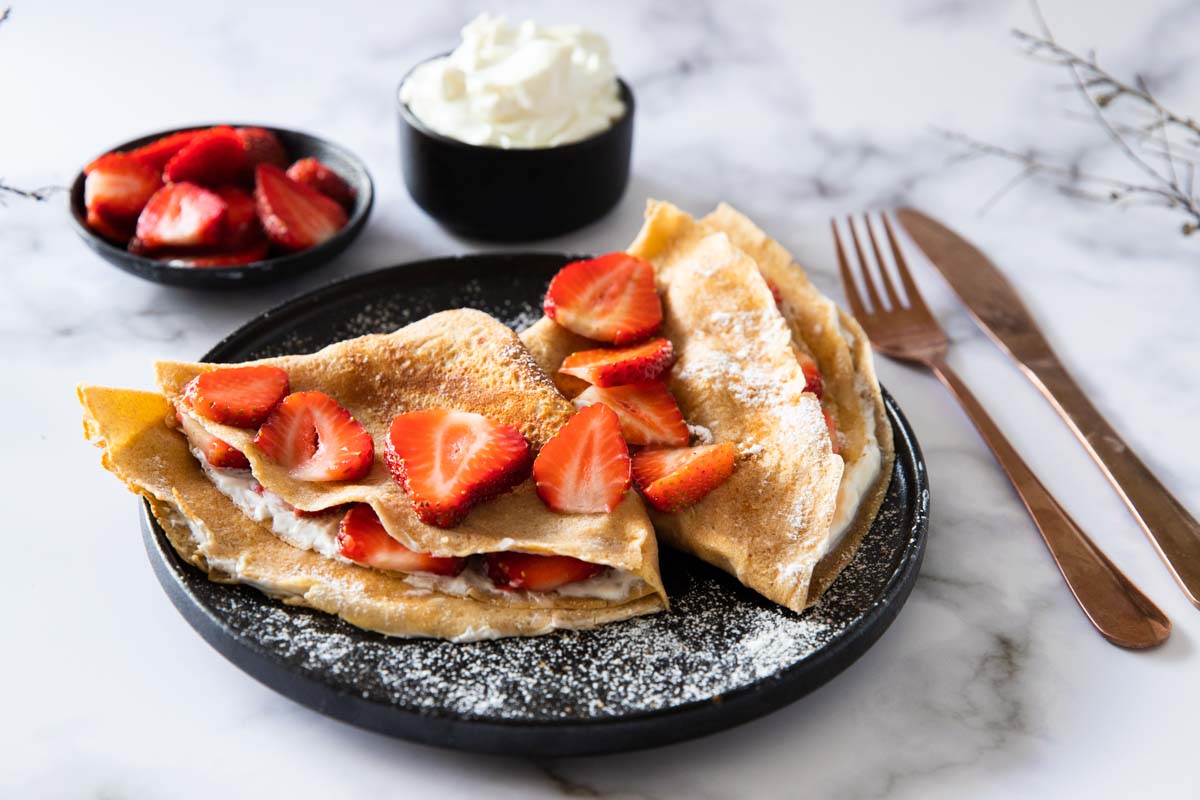Buttery squares of puff pastry are filled with juicy blueberries in a tart lemon cream cheese filling, then topped with sliced almonds and lemon curd. These easy-to-make danishes – wienerbrød in Denmark- are perfect alongside a steaming cup of tea or coffee for a cheerful and delicious breakfast.

Country Number 47: Denmark
Hej and welcome to Denmark! This picturesque Scandinavian country is nestled between Sweden and Germany, and acts as the connection point to Europe for the rest of Scandinavia. Both Nicola’s and my own experiences of Denmark are limited to Copenhagen, so hopefully in giving you the low-down on what this stunning city is like we shall give you a wee taste of Danish life. We arrived in Copenhagen late at night by an evening train, so my first sleepy impressions of the city were of lights sparkling on the canal, the sound of water lapping gently against boats, and the swanky interior of our water-front hotel. The next morning my breath was taken away as we emerged into the cool winter light and I was able to take in the city in its full splendour. I can quite honestly say that Copenhagen is one of the most beautiful cities that I have visited.

I was awestruck as we walked along the pastel-fronted buildings of Nyhavn, with their reflections shimmering in the water, and realised that we had in fact trodden this same path the night before, with the darkness obscuring the splendour of Copenhagen’s main canal. Upon meandering along this beautiful waterfront, it is easy to comprehend why Hans Christian Andersen made Nyhavn his home for 18 years. Apparently, however, during the 19th century the area was renowned for its colourful characters: as a cargo-offloading area and spot for fishermen, its many alehouses were frequented by sailors and prostitutes. As such, I’m sure his experience of the spot would be very different from our own. Today it’s been revamped to act as a public square, with its restaurants and pubs visited by tourists and locals alike, and its canal has been repurposed to house veteran ships.


We had a lot of fun scampering around Copenhagen; popping into interesting shops, catching rides at the sparkling, whimsical Tivoli theme park, and swinging by various bakeries to escape the cold and get our mitts (literally) on pastries and coffee. Delicious wienerbrød (Danishes) really make the biting cold far more tolerable I must say. As such, when we reached Denmark on our cooking challenge, we couldn’t resist attempting to recreate some of the goodness we had sampled.
History of Danish Cuisine
Danish cuisine began in the form of the region’s local peasant dishes in the pre-Industrial Revolution era. This generally involved various rye breads, beers, smoked and salted fish and meat products, and potatoes. With the Industrial Revolution, fresh produce and dairy became more popular in the cuisine, and due to its position as a key sea-port, it was common to incorporate foreign spices such as nutmeg, cardamom, cinnamon and black pepper. Today, Denmark is at the centre of the New Nordic Cuisine movement, which focuses on cooking seasonal local produce with a mixture of innovative and traditional methods to create remarkably flavoursome dishes. This movement has really put Denmark on the culinary map, and we were lucky enough to sample some remarkable dishes at a few beautifully innovative restaurants in town. Nic and I still have a dream of one day visiting Noma, Copenhagen’s two-Michelin star restaurant, rated the number two restaurant in the world, which has a dedicated vegetarian menu for part of the year.
Wienerbrød, meaning ‘Viennese bread’, or Danishes, as they are known as by English-speakers, get their name from the Austrian bakers who introduced the pastry to Denmark in the 19th century. They come in various shapes and forms in Denmark: they can be found in figure-eights, spirals (snails), kringles (pretzel-shaped) and circles with filling (spandauers). Their toppings vary from chocolate to glacé icing, pearl sugar or nuts, and they can be stuffed with various fruits, preserves, marzipan or custard. Basically, whatever your sweet-toothed predilection, these pastries are bound to satisfy.
Popular Danish Vegetarian Dishes
- Brunede Kartofler – caramelised browned potatoes, served as a side-dish.
- Risalamande – almond rice pudding generally served as Christmas dessert.
- Koldskål – cold buttermilk soup served with strawberries and biscuits.
- Rugbrød – rye bread most commonly used to make Smørrebrød, or open-sandwiches.
- Wienerbrød – known internationally as Danishes, these flaky buttery pastries come in a variety of shapes and with a variety of fillings.
Vegetarian rating of Danish Cuisine:
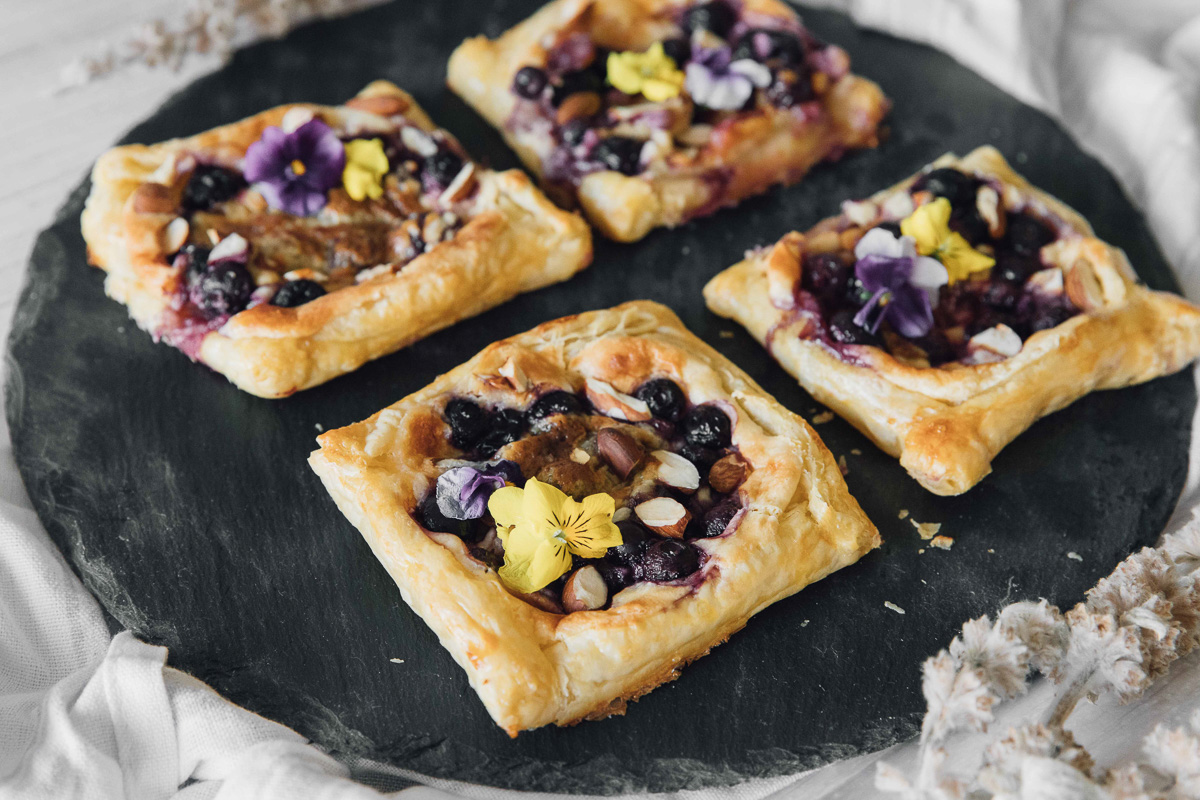
Making Wienerbrød
I’m not going to lie to you, these pastries are a lot easier and quicker to make if you use store-bought puff pastry. If you want to go the full monty and make the pastry from scratch for that extra authenticity, please be our guest! It would definitely elevate them to that extra level. As for us, we simply de-thawed store-bought puff pastry before-hand to make it much easier to make these pastries in the morning before work, and they were pretty damn tasty. You can also pick and choose whatever shape and filling you want: a couple of options are poached cinnamon apple Danishes, or marzipan almond-topped Danishes.
How to make Wienerbrød
There are various different methods for folding the pastry of Danishes depending on what shape you want them to be. We went with the edged rectangle method for our danishes, however, you can take a look at this website if you want to pick another shaping method.
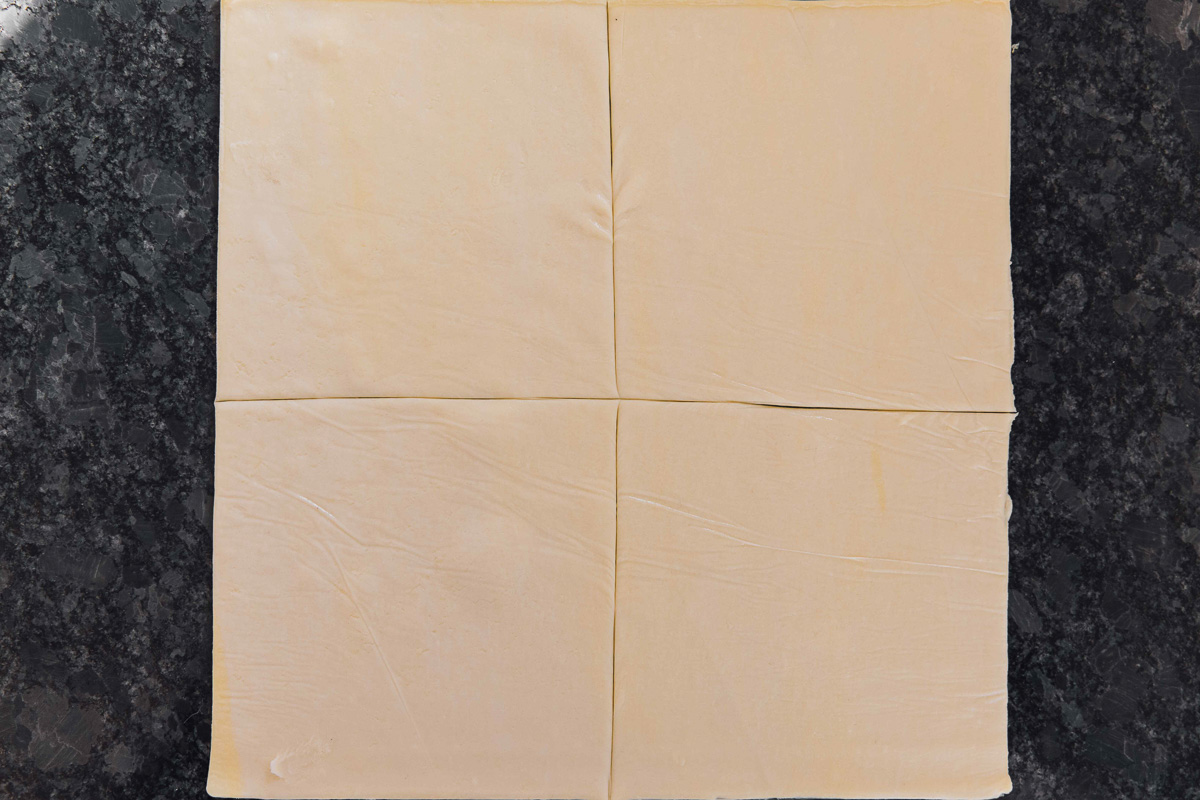

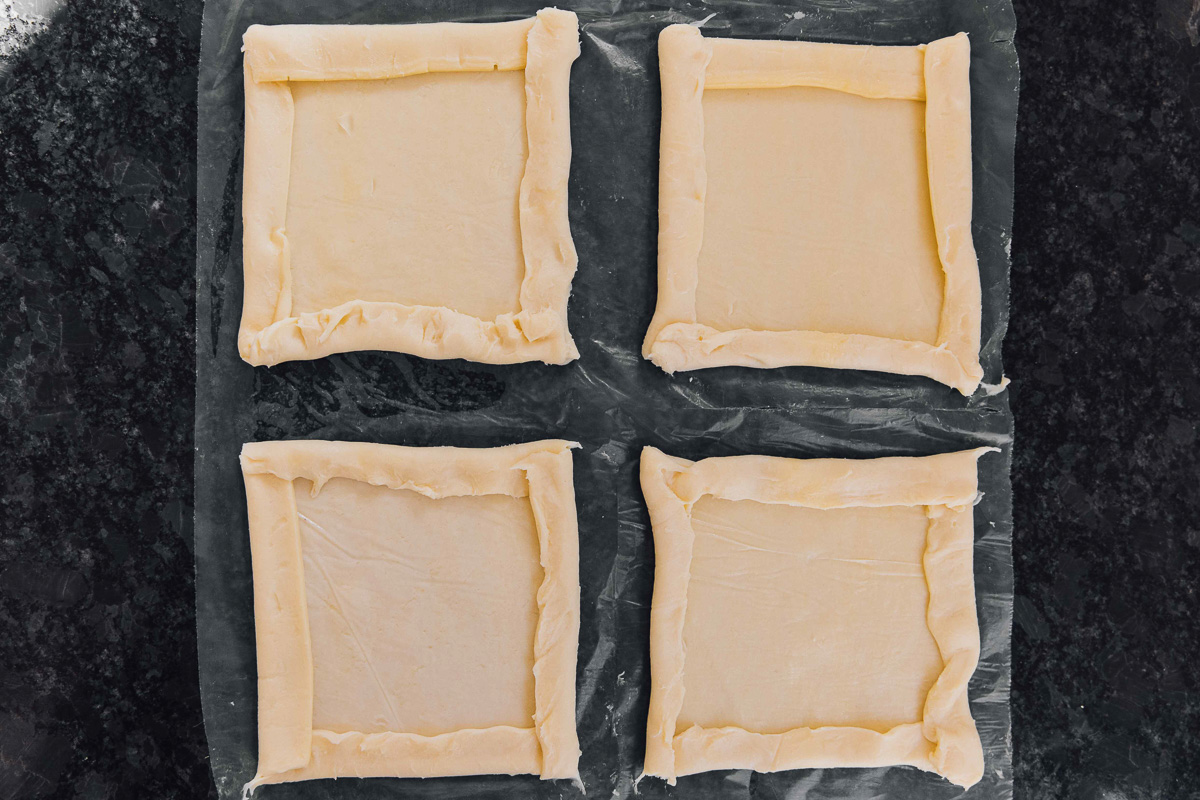
1. Preheat oven to 200 C. Once you have decided on the shape of your puff pastry Danishes, cut the thawed but still cold dough on a lightly floured surface according to the shapes you want them to form. Transfer rectangles (or other shaped Danishes) onto a baking paper-lined baking tray.

2. In a medium bowl, beat together cream cheese, sugar, lemon juice and zest, vanilla essence, until well-combined.
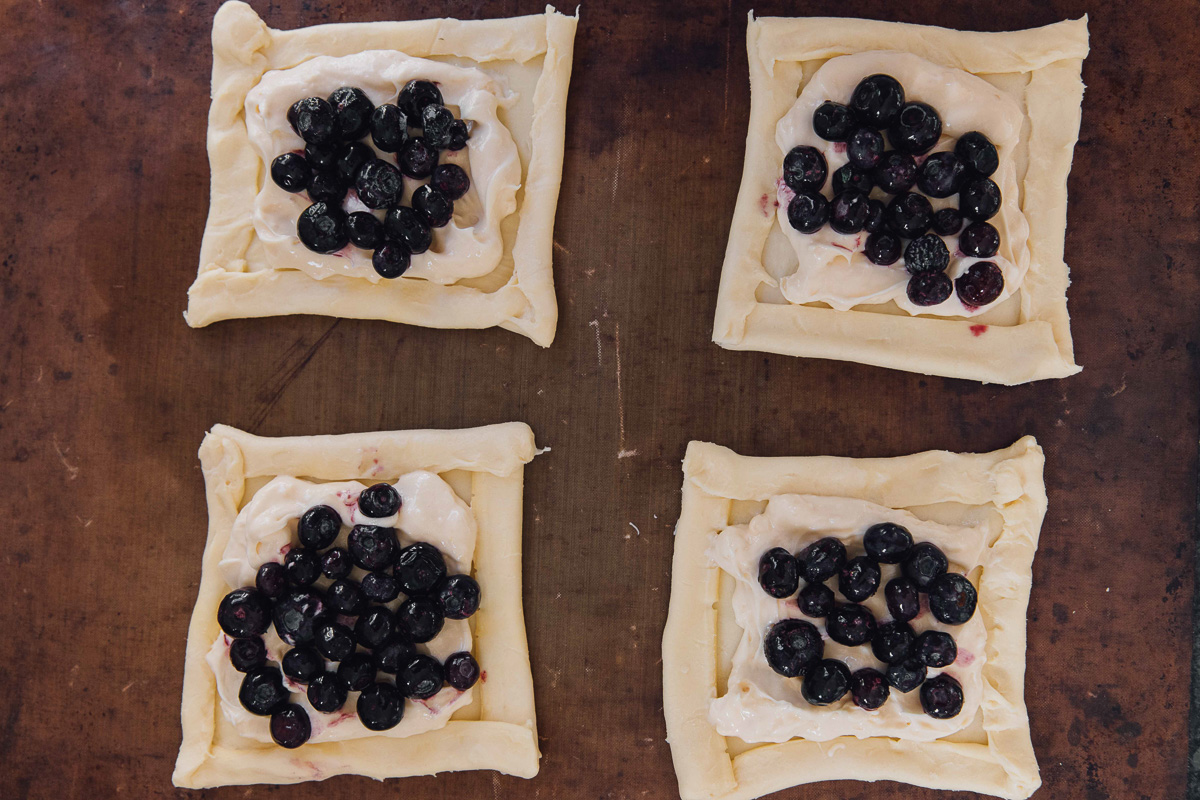
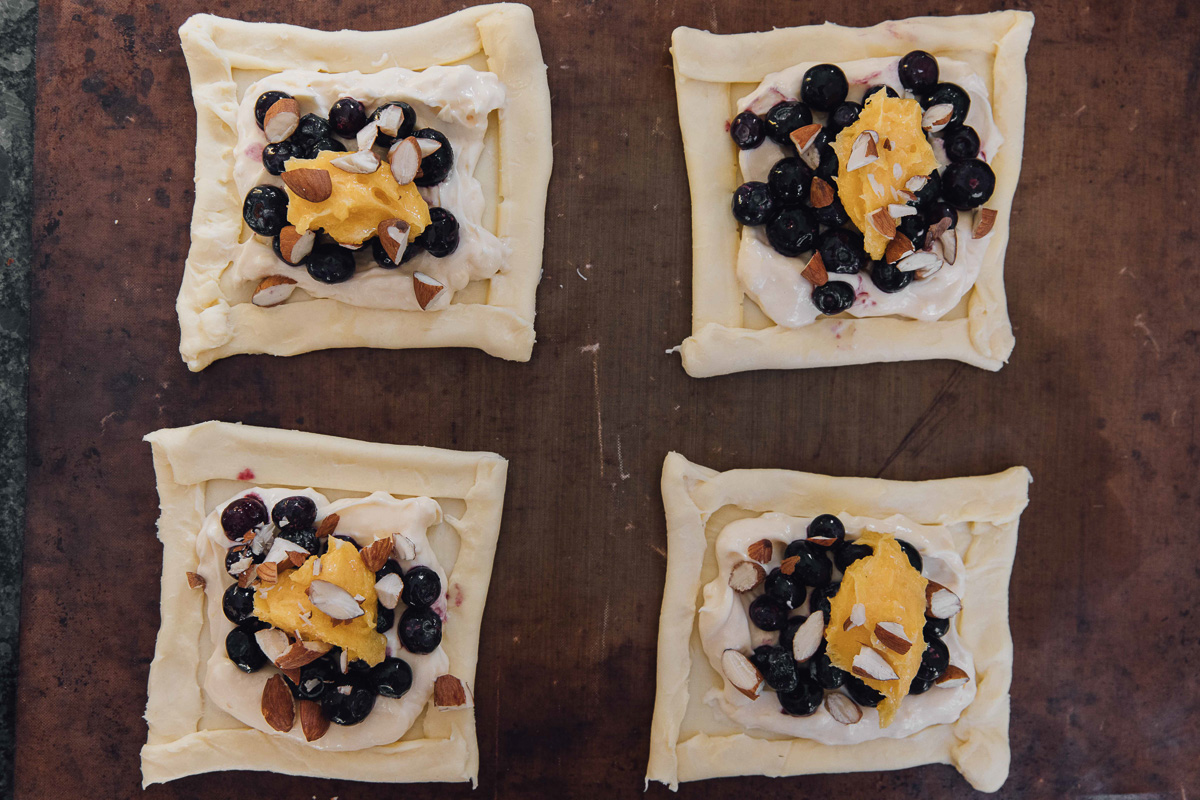
3. Place 2 tbsp of cream cheese mixture into the centre of your pastry dough. Top with 8 or so blueberries, a blob of lemon curd, and slithered almonds. Beat together egg with a splash of milk. Brush the edges of each pastry with the egg glaze.
4. Bake in oven for around 20 minutes, or until golden brown and puffed up. Dust with icing sugar, and enjoy!
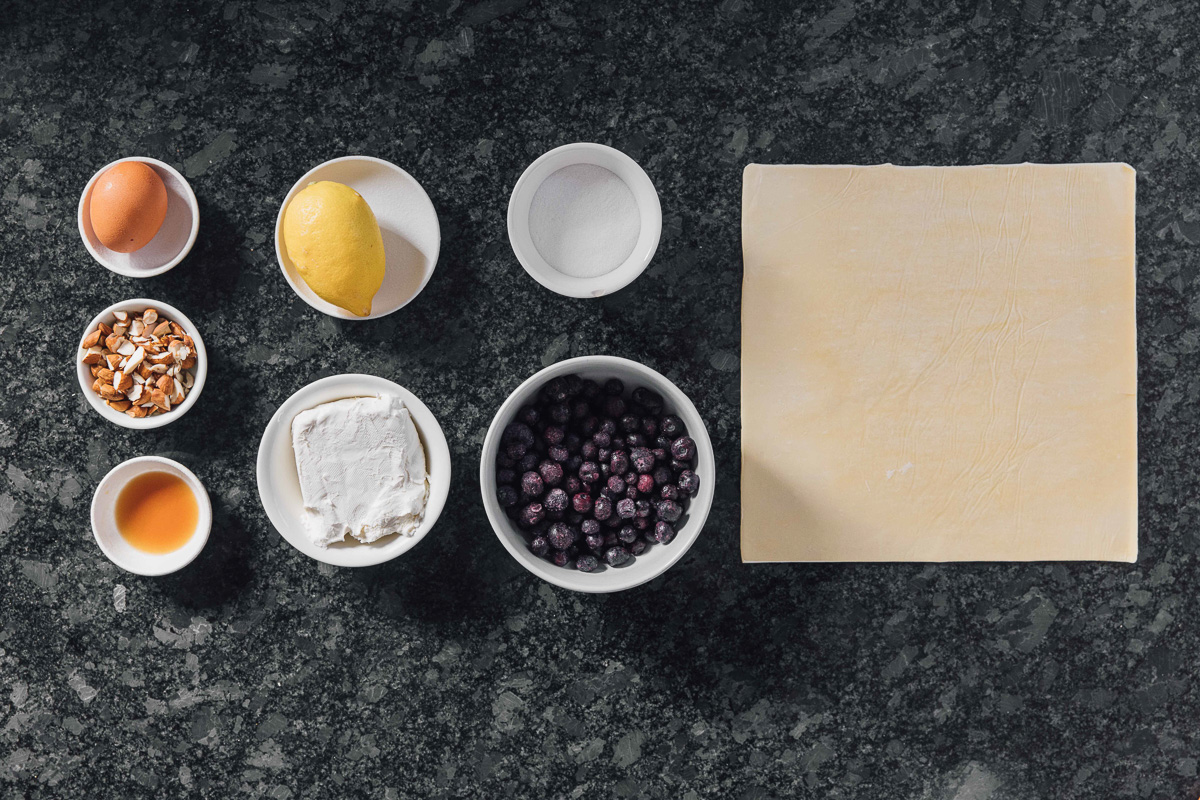
Ingredient notes for Puff Pastry Danishes with Blueberry and Cream Cheese
- Blueberries – These can be fresh or frozen (if frozen, don’t thaw before cooking), and you can substitute them with any other berries or fruit you so desire.
- Lemon curd – once again, feel free to substitute with a jam, preserve, or marzipan if you’d prefer.
- Lemon juice and zest – orange juice and zest are a good alternative.
- Almonds – omit to make nut-free, or select your nut of choice.
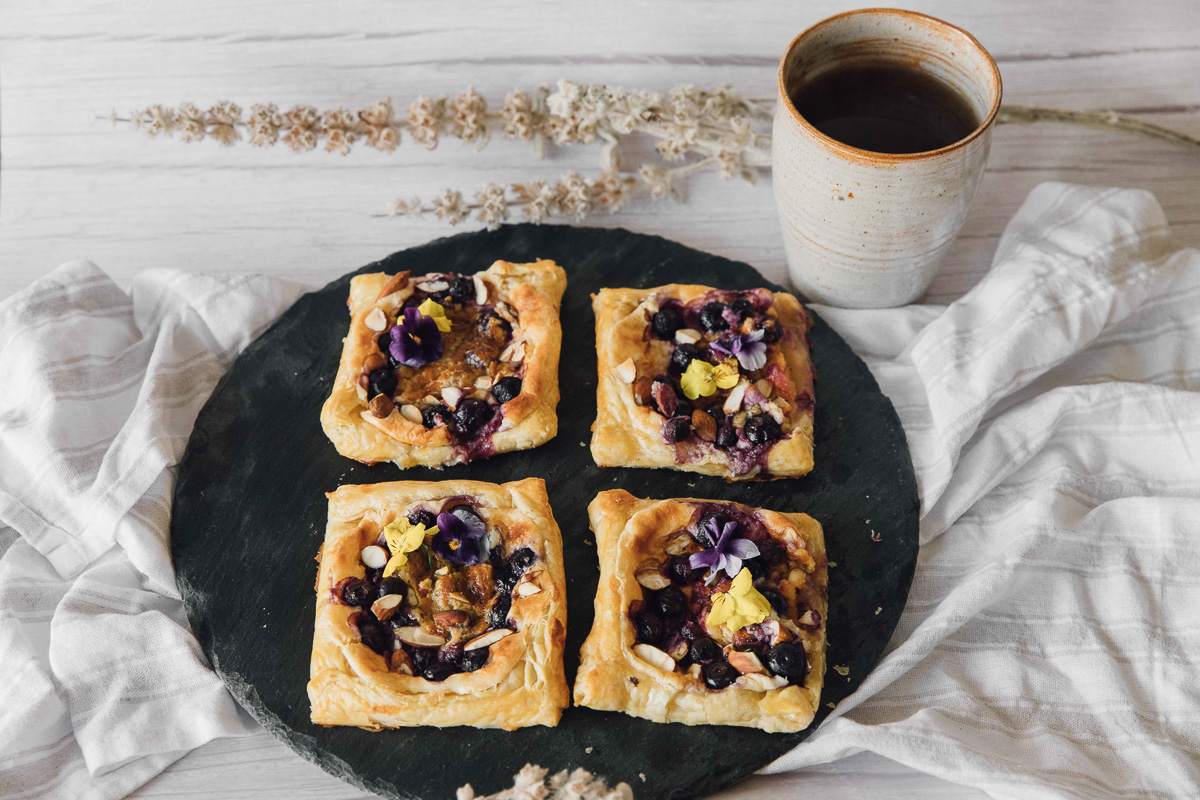
Serving suggestions for Wienerbrød
Serve these blueberry cream cheese danishes fresh from the oven with a cup of steaming hot tea or coffee.
Other European sweet dishes to try:
- Tufahije Recipe: Walnut-Stuffed Poached Apples from Bosnia
- Belgian Liege Waffles Recipe with Speculoos Sauce
- Torrejas Recipe: Cinnamon French Toast from Andorra
Like this wienerbrød recipe? Pin it for later!
